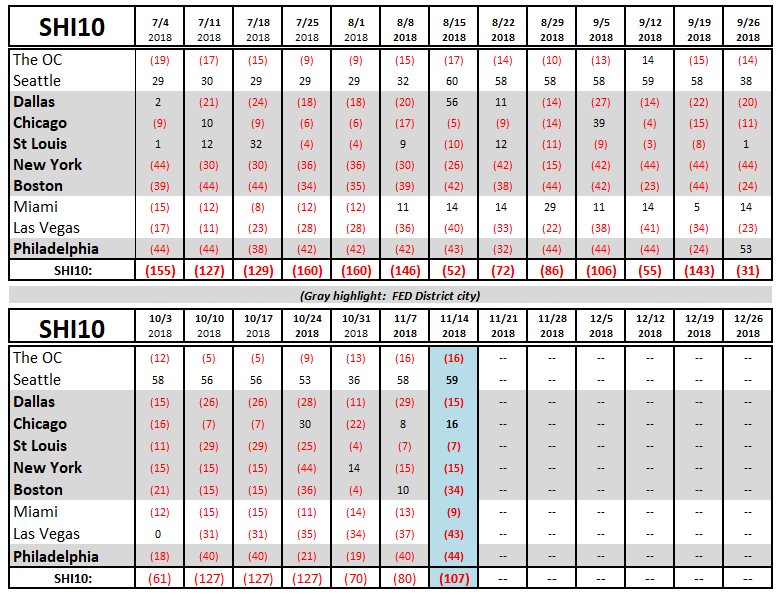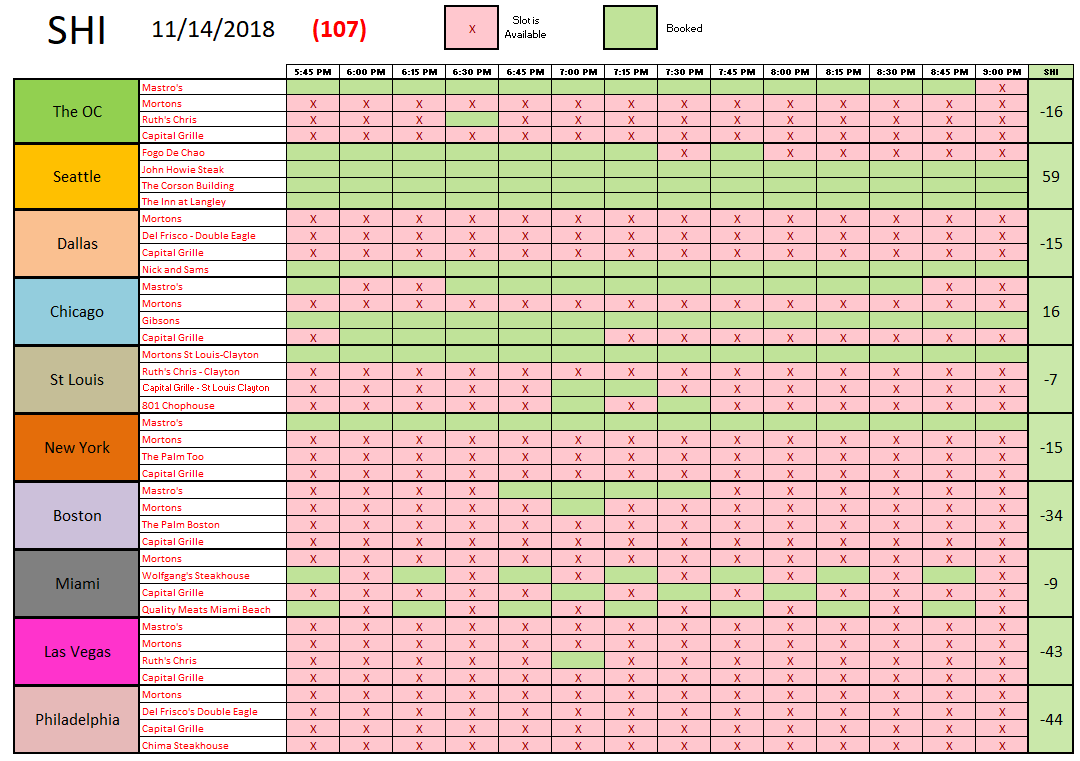SHI 11.14.18 – Eat at Mastro’s

SHI 11.07.18 Good News? Bad News?
November 7, 2018
SHI: 11.21.18 – A Blueprint to Follow?
November 21, 2018
“They need your help. Because our population is aging. Rapidly. And while older folks do spend money, they probably don’t spend much at Mastros, Ruths’ Chris or any other extravagant steakhouse.”
In fact, according to Harvard University, older folks will be hard pressed to afford even basic necessities, such as rent. Here’s a quote from a recent paper on aging, published by the ‘Joint Center for Housing Studies’ at Harvard:
“Many older households rely largely on Social Security benefits as their main source of income. Indeed, Social Security payments accounted for 69 percent of the income for the median older household in 2016.
But between 2006 and 2016, Social Security payments rose just 6 percent in real terms while the median rent for households age 65 and over climbed at twice that rate. Looking ahead, the ability of many older adults to afford their housing will be closely tied to the fate of the Social Security program.”
I suspect you are as surprised as I am: Social Security payments represent 69% of older household median income? Wow…that’s staggering.
In prior blogs, I’ve talked extensively about US demographics…and the implications on the overall economy. But what impact will aging have on expensive steakhouses? Will a 60-something couple, barely able to pay monthly rent, splurge for a $400 dinner-for-2 at Mastros? I doubt it.
What does this imply for US GDP growth and the economy as a whole?
Welcome to this week’s Steak House Index update.
If you are new to my blog, or you need a refresher on the SHI10, or its objective and methodology, I suggest you open and read the original BLOG: https://www.steakhouseindex.com/move-over-big-mac-index-here-comes-the-steak-house-index/
Why You Should Care: The US economy and US dollar are the bedrock of the world’s economy. This has been the case for decades … and will continue to be true for years to come.
Is the US economy expanding or contracting?
According to the IMF (the ‘International Monetary Fund’), the world’s annual GDP is about $80 trillion today. US ‘current dollar’ GDP now exceeds $20.66 trillion. In Q3 of 2018, nominal GDP grew by 4.9%. We remain about 25% of global GDP. Other than China — a distant second at around $11 trillion — the GDP of no other country is close.
The objective of the SHI10 and this blog is simple: To predict US GDP movement ahead of official economic releases — an important objective since BEA (the ‘Bureau of Economic Analysis’) gross domestic product data is outdated the day it’s released. Historically, ‘personal consumption expenditures,’ or PCE, has been the largest component of US GDP growth — typically about 2/3 of all GDP growth. In fact, the majority of all GDP increases (or declines) usually results from (increases or decreases in) consumer spending. Consumer spending is clearly a critical financial metric. In all likelihood, the most important financial metric. The Steak House Index focuses right here … on the “consumer spending” metric. I intend the SHI10 is to be predictive, anticipating where the economy is going – not where it’s been.
Taking action: Keep up with this weekly BLOG update. Not only will we cover the SHI and SHI10, but we’ll explore related items of economic importance.
If the SHI10 index moves appreciably -– either showing massive improvement or significant declines –- indicating growing economic strength or a potential recession, we’ll discuss possible actions at that time.
The BLOG:
By 2016, according to the recent Harvard University study on ‘Aging,’ US demographics saw a significant change:

The image on the left is from the year 2000. On the right, the year 2016. Census tracts where the majority of residents were 50+ years in age more than tripled during that time period. The ‘brown‘ areas reflect areas where homes of 50+ year-old folks are concentrated.
How might Mastro’s feel about this metric? Well, according to their website, the do NOT have any restaurants in Oregon. Or Idaho. Or Montana. And that’s probably a good thing. For Mastro’s. So I suspect the company is feeling pretty good right now. In most of their restaurant locations, the general population is younger and still spending plenty on ‘experiences.’ Regardless of expense. You may have also noticed they consistently attract more reservation demand than their other high-brow competitors. Across the country, week after week, Mastro’s appears to be the most popular steakhouse.
What is the larger demographic impact to our economy? Big picture, not good, frankly. Remember, our economy is ‘consumption driven’ … unlike the economies of Germany or Japan, which are ‘export driven.’ If a household is struggling to pay rent, since much of their income comes from Social Security, they have little if any discretionary income to spend on luxuries or extravagances.
The take-away here is this: Don’t worry too much about the demographic dynamic today. This is yet another slow-moving problem. But 15 years from now? Yep, if nothing changes, it will be high time to really worry. Or to drink copiously. Because expensive wines will probably be much cheaper.
Why? Because like all global consumer products, a 1990 Chateau Margaux is subject to the laws of supply and demand. And if demand wanes, due to an aging and spendthrift population, that bottle of wine will probably cost a lot less. Plenty of folks will still be able to afford expensive wine and steaks. But that group, as a percentage of total population, will be shrinking in size. And these evolving demographics will play a big part in the continuing polarization between the ‘haves’ and the ‘have-nots.’
But for now, the US economy is sizzling hot. As we’ve discussed in the past few blogs. Let’s take a look at the SHI and SHI10 readings for this week:

Big picture, reservation demand is fairly consistent this week — with the one HUGE exception being Boston. Between last week and today, the SHI in Boston saw a 44-point swing — to the negative. Wow. This Saturday, folks in Boston must be eating lobster. Vegas and Philly experienced a slight drop in demand and many other markets saw improvement.
Here are the individual market SHI readings:

Take a close look at the grid above. With Vegas as the exception, from top-to-bottom, the cities tend to be from west-to-east. Do you notice anything interesting? Yes … reservation demand seems higher in the west than the east.
Our economy is ‘consumption driven.’ We are not a manufacturing powerhouse, like Germany or Japan. We once were … in years gone by … but are no longer. The current administration has, among other things, focused on the US manufacturing and has had some success jump-starting this declining sector. This may become an important paradigm shift as other countries grow richer — such as China, India and other areas in the east — and become larger consumers.
Automation is the future reality. Can it fuel a manufacturing rebirth here in the US? Great question, right? I’ll be talking more about this in future blogs. So stay tuned!
– Terry Liebman




